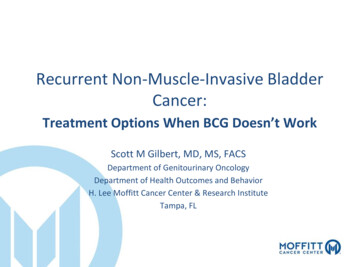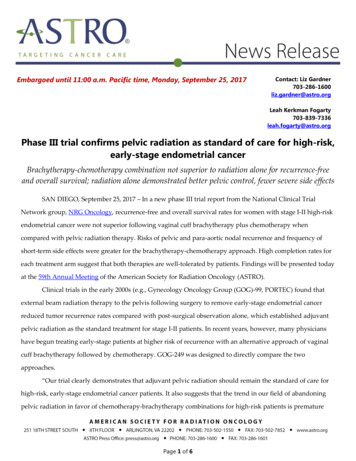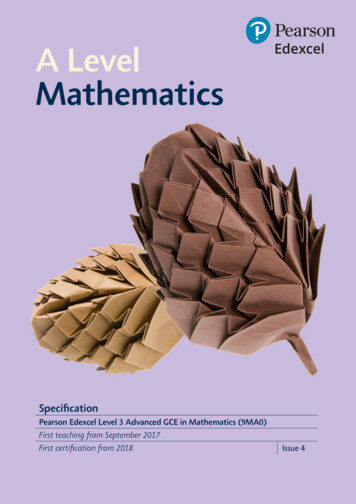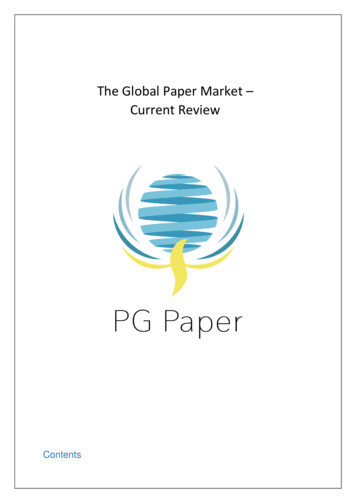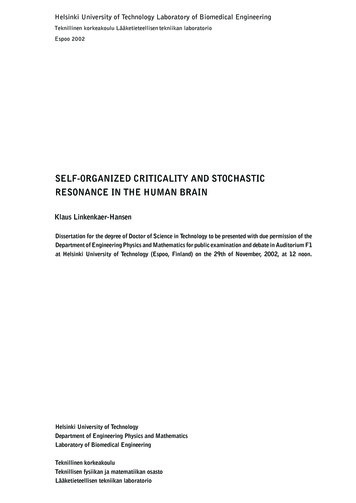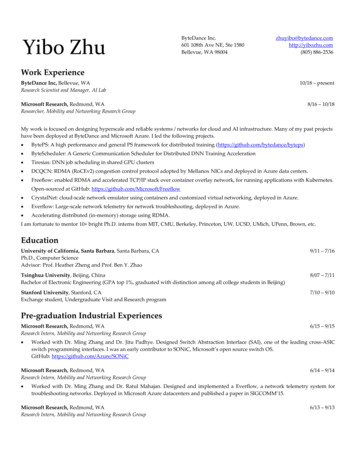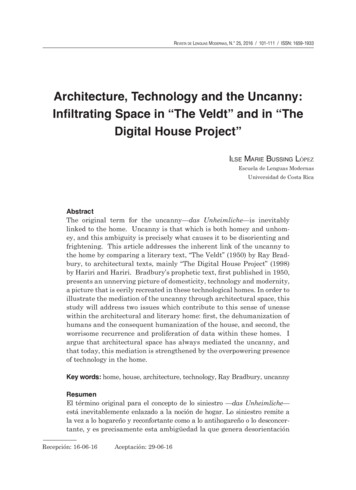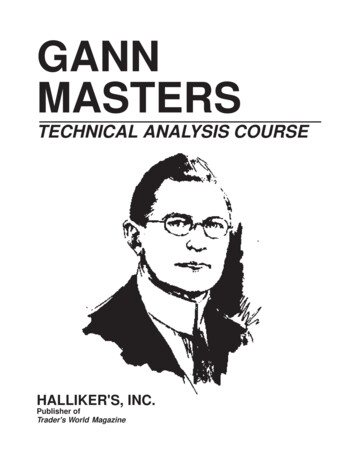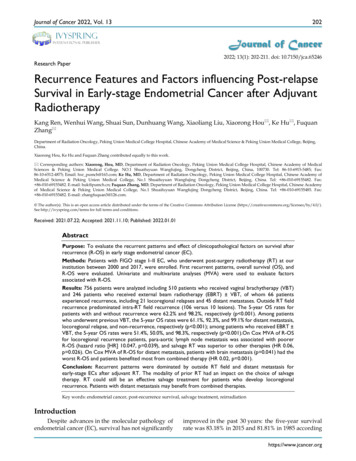
Transcription
Journal of Cancer 2022, Vol. 13IvyspringInternational PublisherResearch Paper202Journal of Cancer2022; 13(1): 202-211. doi: 10.7150/jca.65246Recurrence Features and Factors influencing Post-relapseSurvival in Early-stage Endometrial Cancer after AdjuvantRadiotherapyKang Ren, Wenhui Wang, Shuai Sun, Dunhuang Wang, Xiaoliang Liu, Xiaorong Hou , Ke Hu , FuquanZhang Department of Radiation Oncology, Peking Union Medical College Hospital, Chinese Academy of Medical Science & Peking Union Medical College, Beijing,China.Xiaorong Hou, Ke Hu and Fuquan Zhang contributed equally to this work. Corresponding authors: Xiaorong, Hou, MD, Department of Radiation Oncology, Peking Union Medical College Hospital, Chinese Academy of MedicalSciences & Peking Union Medical College. NO.1 Shuaifuyuan Wangfujing, Dongcheng District, Beijing, China, 100730. Tel: 86-10-6915-5485; Fax:86-10-6512-4875; Email: hxr pumch@163.com; Ke Hu, MD, Department of Radiation Oncology, Peking Union Medical College Hospital, Chinese Academy ofMedical Science & Peking Union Medical College, No.1 Shuaifuyuan Wangfujing Dongcheng District, Beijing, China. Tel: 86-010-69155482. Fax: 86-010-69155482. E-mail: huk@pumch.cn; Fuquan Zhang, MD, Department of Radiation Oncology, Peking Union Medical College Hospital, Chinese Academyof Medical Science & Peking Union Medical College, No.1 Shuaifuyuan Wangfujing Dongcheng District, Beijing, China. Tel: 86-010-69155485. Fax: 86-010-69155482. E-mail: zhangfuquan3@126.com. The author(s). This is an open access article distributed under the terms of the Creative Commons Attribution License (https://creativecommons.org/licenses/by/4.0/).See http://ivyspring.com/terms for full terms and conditions.Received: 2021.07.22; Accepted: 2021.11.10; Published: 2022.01.01AbstractPurpose: To evaluate the recurrent patterns and effect of clinicopathological factors on survival afterrecurrence (R-OS) in early stage endometrial cancer (EC).Methods: Patients with FIGO stage I–II EC, who underwent post-surgery radiotherapy (RT) at ourinstitution between 2000 and 2017, were enrolled. First recurrent patterns, overall survival (OS), andR-OS were evaluated. Univariate and multivariate analyses (MVA) were used to evaluate factorsassociated with R-OS.Results: 756 patients were analyzed including 510 patients who received vaginal brachytherapy (VBT)and 246 patients who received external beam radiotherapy (EBRT) VBT, of whom 66 patientsexperienced recurrence, including 21 locoregional relapses and 45 distant metastases. Outside RT fieldrecurrence predominated intra-RT field recurrence (106 versus 10 lesions). The 5-year OS rates forpatients with and without recurrence were 62.2% and 98.2%, respectively (p 0.001). Among patientswho underwent previous VBT, the 5-year OS rates were 61.1%, 92.3%, and 99.1% for distant metastasis,locoregional relapse, and non-recurrence, respectively (p 0.001); among patients who received EBRT VBT, the 5-year OS rates were 51.4%, 50.0%, and 98.3%, respectively (p 0.001).On Cox MVA of R-OSfor locoregional recurrence patients, para-aortic lymph node metastasis was associated with poorerR-OS (hazard ratio [HR] 10.047, p 0.039), and salvage RT was superior to other therapies (HR 0.06,p 0.026). On Cox MVA of R-OS for distant metastasis, patients with brain metastasis (p 0.041) had theworst R-OS and patients benefited most from combined therapy (HR 0.02, p 0.001).Conclusion: Recurrent patterns were dominated by outside RT field and distant metastasis forearly-stage ECs after adjuvant RT. The modality of prior RT had an impact on the choice of salvagetherapy. RT could still be an effective salvage treatment for patients who develop locoregionalrecurrence. Patients with distant metastasis may benefit from combined therapies.Key words: endometrial cancer, post-recurrence survival, salvage treatment, reirradiationIntroductionDespite advances in the molecular pathology ofendometrial cancer (EC), survival has not significantlyimproved in the past 30 years: the five-year survivalrate was 83.18% in 2015 and 81.81% in 1985 accordinghttps://www.jcancer.org
Journal of Cancer 2022, Vol. 13to the Surveillance, Epidemiology, and End Results(SEER) database [1, 2]. Therefore, reducing the failurerate of post-therapy and improving the survival ofECs is the current focus [1]. Radiotherapy (RT) is animportant part of the adjuvant treatment regimens forEC, which reduces the locoregional recurrence andfurther improves survival [3]. However, despitecurative surgery and adjuvant RT received,approximately 15% of patients with early stageEC still develop recurrence [4].Recurrence after curative treatment has a strongnegative impact on survival [5, 6]. Thus, improvingsurvival after recurrence (R-OS) is another key toenhancing prognosis. R-OS is influenced by multiplefactors including failure patterns, previous treatment,and salvage treatment [7]. Previous studiesdemonstrated that patients with recurrence who didnot receive previous RT had better R-OS [8].Lindemann et al. proposed RT for the salvagetreatment of isolated pelvic relapse rather than theprimary adjuvant regimen because the rate of salvageRT was higher in RT-naïve patients than those whoreceived RT [9]. Thus, the primary adjuvant treatmentmodality has a profound impact on salvage treatmentchoice. Although the type of adjuvant RT did notaffect overall survival according to GOG 249 andPORTEC-2 [10, 11], patients with locoregionalrecurrence who received prior RT, especially thepelvic radiation, may not be considered thereirradiation due to cumulative toxicities [6, eness of previous RT mode on R-OS andfeasibility of reirradiation are still lacking.Management options for recurrent patientsinclude pelvic exenteration, RT/re-irradiation,chemotherapy, or the combination of them [13, 14].Decisions regarding salvage treatment regimens canbe complicated because multiple factors should beconsidered including the relapse site and primarytreatment, especially RT history. It remainschallenging to achieve a balance between radicalintent and tolerance of the normal organs in thesetting of re-irradiation for intra-field recurrences [12,14]. To date, few studies have directly compareddifferent salvage treatment regimens for recurrentearly stage ECs in patients who underwent previousRT.Considering the limited understanding of themanagement of recurrent EC, the present study aimedto clarify the first recurrence patterns in detail. Weevaluated the clinicopathological and previoustreatment-related characteristics associated with R-OSand analyzed the effectiveness of various salvagetreatments categorized according to recurrence site togain a comprehensive understanding of risk factor-203outcome relationships of early stage ECs.Materials and methodsPatient characteristicsThe present study retrospectively reviewed theEC patients between Jan 2000 to Dec 2017 at PekingUnion Medical College Hospital. The inclusioncriteria for this study were as follows: diagnosis ofstage I–II EC according to the 2009 InternationalFederation of Gynecology and Obstetrics (FIGO);underwent surgery at Peking Union Medical CollegeHospital, including radical hysterectomy andunilateral or bilateral salpingo-oophorectomy with orwithout pelvic and para-aortic lymph node dissection;and received post-surgery adjuvant radiotherapy;with complete surgical pathology data and oaches were uncertain, those who did notcomplete adjuvant treatment, those with incompleteinformation regarding pathological and recurrencesites, and those with a follow-up 6 months wereexcluded. Epidemiological data, previous and salvagetreatment information, and follow-up records werecollected and analyzed.Previous treatment regimenThe adjuvant treatment included EBRT, VBT,EBRT VBT, and chemotherapy. The decision ofadjuvant treatment was based on the pathologicalcharacteristics, mode of primary surgery, physicalstatus, the willingness of patient, and discretion ofdoctors. The risk classification of the patient wasredefined by the European Society for MedicalOncology (ESMO) – European Society ofGynecological Oncology (ESGO) – European Societyfor Radiotherapy & Oncology (ESTRO) [15].EBRT alone was delivered with a total dose of 45to 50.4 Gy in 23-28 fractions. The target volume ofEBRT covered the region of the vaginal cuff, theproximal half of the vagina, and the pelvic lymphnode drainage area. VBT only was administered usinga high-dose-rate (HDR) iridium source (Ir-192) after aloading technique at 5 Gy per fraction within 5 to 6fractions. For the group of EBRT VBT, EBRT wasadministered with a total dose of 39.6Gy to 50.4Gy,and the following VBT was delivered at doses rangingfrom 4 to 6 Gy per fraction in 2 to 4 fractions. Avaginal cylinder was delivered 5 mm below thevaginal surface, and the target volume covered thevaginal cuff and proximal half of the vagina.Patients received chemotherapy based on theirclinicopathological factors and the discretion of theirdoctor. The chemotherapy regimens consisted ofconcurrent weekly regimen (cisplatin-based) orsequential three-weekly regimen (carboplatin/https://www.jcancer.org
Journal of Cancer 2022, Vol. 13204paclitaxel, intravenously).Statistical analysisRecurrence patterns classified according tosite and previous radiation fieldOverall survival (OS) was defined as the periodfrom the date of primary surgery to the date of deathor the last follow-up. R-OS for recurrent patients wasdefined as the period from the date of the firstrecurrence to the date of death or last follow-up.Disease-free interval (DFI) was defined as the intervalbetween the initiation of treatment and the firstrelapse.A Cox proportional hazards regression analysiswas used to analyze the effectiveness of allparameters on R-OS. Univariate analysis (UVA)incorporated factors including age, risk groups,histological type, DFI, recurrence mode, and primaryand salvage treatment regimens. Parameters with pvalues 0.1 in the univariate analyses of the wholepatients were included in the multivariate Coxproportional hazards model. Differences with p 0.05were considered to be statistically significant. Datawere analyzed using SPSS version 26.0 (IBMCorporation, Armonk, NY, USA).Recurrence was evaluated by the clinicalsymptoms and signs, laboratory results, pathologicalbiopsy if possible, and radiological examinationresults including abdominal, pelvic ultrasound,computed tomography (CT), magnetic resonanceimaging (MRI), or positron emission tomography-CT(PET-CT). First recurrence events were categorized aslocoregional recurrence or distant metastasis.Locoregional recurrence was defined as pelvic andregional recurrences including vaginal, pelvic, andpara-aortic lymph nodes metastasis (PALM).Recurrences located beyond the area of pelvic andpara-aortic and spread to the distant viscera andremote lymph nodes, including the lung, liver, bone,brain,inguinal lymph nodes,andthesusdiaphragmatic lymph nodes, were categorized asdistant metastases.Locoregional recurrences were further classifiedas intra-RT field and outside RT field depending onwhether or not recurrence lesions were located withinthe prior radiation field. For the patients who receivedprevious pelvic EBRT VBT, recurrences locatedbeyond the pelvic irradiated area were defined asoutside RT field recurrence. For the patients whoreceived previous VBT alone, recurrences locatedbeyond the area of the vaginal cuff and proximal halfof the vagina were defined as outside RT fieldrecurrence.Salvage treatment and toxicity evaluationSalvage treatment consisted of surgery,radiotherapy (RT), chemotherapy (CT), combinedtherapies (at least two types of treatment modalitiessuch as RT plus CT, RT plus surgery, or thecombination of RT, CT, and surgery), and othertherapies (including endocrine treatment, palliativecare).Salvage RT consisted of VBT with or withoutEBRT or EBRT alone. EBRT was administered rapy. For patients with locoregionalrecurrences, EBRT was delivered at a dose of 45 to50.4 Gy in 25 to 33 fractions, followed by a boost to thetumor region at the maximum dose of 20 Gy. SalvageVBT alone was administered with three-dimensionalimage-guided HDR Ir-192 after the loading techniqueof 30 Gy at 5 Gy per fraction.Toxicities were evaluated according to theCommon Terminology Criteria for Adverse Events(CTCAE) version 3.0.ResultsPatient characteristicsA total of 756 patients were analyzed with themedian follow-up period of 61 months, 66/756 (8.7%)of patients experienced recurrences. 21/66 (31.8%)patients experienced locoregional recurrence only and45/66 (68.2%) patients developed distant metastasisincluding 6 patients with simultaneous PALM, 6patients with simultaneous vaginal or pelvicrecurrences. Additionally, 10.6% (7/66) of patientsdied after locoregional recurrence, and 47.0% (31/66)died due to distant metastasis. Figure 1 illustrated theprocedure for the analysis approach of the study andpatients’ outcomes.Compared to patients without recurrence, thosewho experienced recurrence were more often 65years old (p 0.010), had a higher pathological grade(p 0.001), higher FIGO stage (p 0.001), and morecommonly classified as high-intermediate risk or highrisk groups (p 0.001) (Table 1).Details of recurrence featuresTable 2 showed the distribution of recurrentlesions according to the prior RT field. Outside RTfield recurrence was the predominant recurrencepattern over the intra-RT field recurrence (106 vs 10lesions). Among the 36 recurrent patients whoreceived prior VBT alone, three recurrent lesions werelocated in the stump or the wall of the vagina withinthe irradiation field and 60 lesions located beyond thefield area. The most common distant metastasis sitelocated outside RT field was the lung.https://www.jcancer.org
Journal of Cancer 2022, Vol. 13205Figure 1. The process and outcome of the study. FIGO: International Federation of Gynecology and Obstetrics; VBT: vaginal brachytherapy; EBRT: external beamradiotherapy; Chemo: chemotherapy; AWD: alive without disease; DOD, died of disease.Table 1. Patient and tumor characteristicsCharacteristicsAge (years) 65 65Pathological typeType 1Type 2Grade†123LVSIYesNoFIGO stageIaIbIIRisk stratificationLow riskIntermediate riskHigh-intermediate riskHigh riskPrior treatment regimenVBT aloneEBRT VBTVBT chemoEBRT VBT chemoWhole patients (n 756)%Without recurrence (n 690)%Recurrence (n 0%41.40%13.00%12311918.20%47.00%28.80% %40%4.50%27281140.90%42.40%16.70% 0%28.80% 10%24.50%3.60%6.80%321841248.50%27.30%6.10%18.20% 0.001Abbreviations: EEC: endometrioid endometrial carcinoma; LVSI, lymph-vascular space invasion. Chemo: chemotherapy. FIGO: International Federation of Gynecology andObstetrics; VBT: vaginal brachytherapy; EBRT: external beam radiotherapy; chemo: chemotherapy.Note: Grade†: Non-endometrioid endometrial types were excluded from this group. Bold indicates p-Value 0.05, considered significant.https://www.jcancer.org
Journal of Cancer 2022, Vol. 13206Table 2. Distribution of the recurrent lesions according to the RTmodalityRecurrent siteVBT (36 recurrencepatients)Intra-field Outside fieldlesionslesions3Stump and upper of thevaginaLower vaginaPelvic/LNPara-aortic LNLungPeritonealLiverBladderExtraperitoneal cavity LNBoneBrainTotal35772265233060EBRT (30 recurrencepatients)Intra-fieldOutside fieldlesionslesions156771055152646Among patients who received prior EBRT VBT,30 patients experienced recurrence. Out of the 7lesions located within the radiation field, the pelvic orpelvic lymph nodes (6/7) were the most commonrecurrence site, followed by the vaginal stump (1/7).Among the 46 outside RT field lesions, lungs were themost frequent recurrent site (10/46) and the brainmetastases (6/46) were more common than thepatients who received prior VBT. Seven lesions werelocated in the para-aortic lymph node drainage area.Of note, a total of ten vaginal lesions were located inthe lower segment of the vagina beyond theirradiation field.Survival outcomeThe 5-year OS for patients with and withoutrecurrence were 62.8% and 97.9%, respectively (p 0.001) (Figure 2A). For patients who underwentprevious VBT alone, the 5-year OS rates for distantmetastasis, locoregional relapse, and non-recurrencepatients were 61.1%, 92.3%, and 97.7%, respectively (p 0.001) (Figure 2B). For patients who receivedprevious EBRT VBT, the 5-year OS rates for distantmetastasis, locoregional relapse, and non-recurrencewere 51.4%, 50.0%, and 99.5%, respectively (p 0.001)(Figure 2C).For the patients with recurrence, the medianR-OS was 45 months. The 1-, 2-, and 3-year R-OS rateswere 74.8%, 61%, and 53.4%, respectively. For patientswith locoregional recurrence, the 3-year R-OS forpatients who received previous EBRT VBT and VBTalone were 29.2% and 80%,respectively (p 0.05). Forpatients with distant metastasis, the 5-year R-OS ofpatients who received previous EBRT VBT were35.9% and 52.7% (p 0.671) (Supplementary Figure 2).Details of the salvage treatmentAmong patients with locoregional recurrence(N 21), eight underwent previous EBRT, and 13received previous VBT alone. Of the eight patientswho received previous EBRT, 25% (2/8) herapy alone, and 12.5% (1/8) received acombination of radiotherapy and resection surgery.One patient who received salvage RT, with theshortest radiation interval of 7 months, experiencedgrade 3 gastrointestinal toxicity and died of tumorprogression. The remaining two patients, whoreceived salvage RT, were alive without progressionduring follow-up (Table 3).Table 3. Details of salvage treatment according to recurrentpatterns and prior RT modesSalvage treatmentOther therapiesRTCTSurgeryCombined therapySurgery RTRT CTCT RT SurgeryTotalToxicitiesG1-G2 G3Treatment resultsAlive withoutdeathDead of ECLocoregional (n 21)VBTEBRT VBT(n 13)(n 8)Distant metastasis (n 45)Total VBTEBRT VBTTotal(n 23) (n s: FIGO, International Federation of Gynecology and Obstetrics; VBT,vaginal brachytherapy; EBRT, external beam radiotherapy; chemo, chemotherapy.G, grade.Among the patients who received previous VBTalone, 46.2% (6/13) underwent salvage RT, 23.1%(3/13) underwent a combination of RT and surgery,and 15.4% (2/13) received chemotherapy alone. Noneof the patients who received salvage radiation or thecombined therapies experienced grade 3 toxicities,and all of these patients were alive without tumorprogression (Table 3). The median time interval of there-irradiation was 25 months (range: 7 to 120 months).The median re-irradiation EBRT dose was 50.4Gy(range: 45 to 70.4Gy) in 25 to 33 fractions, and there-irradiation VBT dose was 30Gy in 6 fractions(Supplementary Table 1).Among patients with distant metastasis (N 45),two patients received salvage RT, 22 patients receivedchemotherapy alone, four patients underwentsurgery, eight patients were administrated withcombined therapies and eight patients received othersalvage therapies. 15 patients developed G1-2toxicities and none of the patients experienced grade 3 toxicities.https://www.jcancer.org
Journal of Cancer 2022, Vol. 13207Figure 2. A-C Kaplan-Meier survival analysis of the OS in all and subgroups of patients. D-F Cox regression model of R-OS in all and subgroups of recurrent patients: (A) OSin the whole cohort according to patients with and without recurrence. (B) OS in the VBT group according to patients with and without recurrence. (C) OS in the EBRT VBTgroup according to patients with and without recurrence. (D) R-OS in all of the recurrent patients categorized by various salvage therapies. (E) R-OS in locoregional patients. (F)R-OS in distant metastasis patients.Cox regression analyses of R-OSFor all patients who experienced recurrence(N 66), 65 years old (p 0.003), higher pathologicalgrade (p 0.025), PALM (p 0.023), DFI 12 months(p 0.022) and salvage treatments other than RT, CT,or surgery (p 0.001) were associated with poorerR-OS. On multivariate Cox analysis, only PALM (HR3.19, p 0.012) and salvage treatment (p 0.001) wereindependent factors for R-OS (Table 1).For patients with locoregional recurrence(s),PALM (p 0.042), previous treatment (p 0.043),previous RT mode (p 0.032), and salvage treatment(p 0.029) were associated with R-OS. Onmultivariate Cox regression analysis, PALM (HR 3.19,p 0.012) was significantly associated with poorerR-OS than in those without PALM (Table 1). Patientswho received salvage RT alone (HR 0.06, p 0.026)had a better R-OS prognosis than those who receivedother therapies with other therapy as a reference(Figure 2E).For patients with distant metastasis, Coxunivariate analysis revealed that age (p 0.021),metastatic site(s) (p 0.021), and salvage treatment (p 0.001) were associated with R-OS. On Coxmultivariate regression modeling, the combinedtreatment regimen improved survival more thanother entities with other therapy as a reference (HR0.024, p 0.001) (Figure 2F). And patients with brainmetastasis had the worst R-OS than patients withother sites of metastasis (p 0.041).Subgroup analysis of patients with PALMAmong the 14 patients who experienced PALM,six developed distant metastasis, six had isolatedPALM, and two experienced concomitant pelviclymph node metastasis. Four PALM patientspresented with abdominal pain, and five with PALMwere asymptomatic and diagnosed using CT orPET/CT. Compared with low-risk patients, PALMwas more common in the high- and intermediate-riskgroups (p 0.04) (Supplementary Table 2). The 3-yearR-OS rates for patients with and without PALM were34.3% and 56.9%, respectively (p 0.016)(Supplementary Figure 1). The result of Coxmultivariate revealed that only salvage RT was asignificant predictor of R-OS (HR 0.02, p 0.024)(Supplementary Table 3).DiscussionOur study elucidated the recurrence features ofearly stage ECs received adjuvant radiotherapy. Wefound that outside RT field recurrences predominatedover the intra-RT field recurrences and distantmetastasis was the majority recurrence pattern. Theprior radiotherapy modalities have different impactson the choice of salvage treatment and influencedsubsequent outcomes after recurrence. Furthermore,multivariate analysis indicated that the salvageregimen was the independent predictor for R-OS. RThttps://www.jcancer.org
Journal of Cancer 2022, Vol. 13208remained the most optimal salvage treatment forlocoregional recurrence with a low incidence ofserious toxicities.Patients who experienced recurrence hadsignificantly poorer outcomes with 5-year OSdecreasing to 62.8% in our study. These results werecomparable to previous studies that Samual R. Franciset al. reported the 5-year OS rate for early stage ECswith recurrence was 58.3% with the median OS of 46.8months [4]. The present study reaffirmed that distantmetastasis was the predominant recurrence patternfor patients who received prior RT, the failure patternwas different from the patients who received surgeryonly, for whom local recurrence including the vaginalvault and nodal rather than distant metastasis is themain recurrent sites [16, 17]. The discrepancy may bedue to the addition of adjuvant RT reducing the rateof vaginal and pelvic relapse [6, 18], the same findingwas previously raised by Carien L. Creutzberg et al.that distant metastasis was the most recurrencepattern for the RT group while the vaginalrecurrences were more common in the patientswithout previous RT [8]. Notably, the result revealedthat most outside RT field recurrences were notaccompanied by the intra-field recurrence, suggestingthat outside RT field relapse maybe not stases possibly existed before RT [19], thushighlighting the importance of systemic treatment[20].The present study also explored the effectivenessof the first course of treatment modalities on survivaloutcomes, and the result indicated that R-OS wasbetter in locoregional patients who received prior VBTalone than EBRT VBT (p 0.05). Further, Cox UVArevealed that the prior VBT alone was associated withimproved R-OS (HR 0.094, p 0.032) but lostindependent significance on Cox MVA. Specifically,the salvage re-irradiation rate of the VBT group was69.2% (9/13) but decreased to only 37.5% (3/8) in theEBRT VBT group.Table 4. Multivariate Cox regression analysis for R-OSAge (years) 65 65GradeG1G2G3Risk stratificationLRIRHIRHRDFI (months) 12 12PALMNegativeMetastasisMetastasis sitesBrainLungLiverOtherMultipleBonePrior RT modeVBTEBRT VBTSalvage treatmentOther therapiesCTRTSurgeryCombined therapyAll patientsHR95% 0.002-0.360.001-0.084Locoregional recurrenceHR95% CIRef10.047p*Distant metastasisHR95% 0.0180.0010.0391.128-89.4820.099 0.001 0.001 0.0010.007 �0.006-1.0880.0750.9390.026—0.058Bold indicates p-Value 0.05, considered significant;p * and p †: only the factors with the p-value 0.05 in the multivariate regression analysis were shown in the table;Abbreviations: Ref, reference.LR, Low risk.IR, Intermediate risk. HIR, High-intermediate risk.HR, high risk. G: pathology grade; HR: hazard ratio; CI: confidence interval;RT: radiotherapy; CT: chemotherapy; R-OS: overall survival after recurrence.https://www.jcancer.org
Journal of Cancer 2022, Vol. 13A similar observation was also reported by afollow-up analysis of the PORTEC-1 trial, with asalvage radiation rate of 93.8% (30/32) in RT-naïvepatients, which decreased to 71.4% (5/7) in patientswho underwent prior radiation [8]. Generally,patients who received previous pelvic radiationwould not be considered for radiation again, inparticular the salvage EBRT, and patients whoreceived VBT alone can be treated as “RT-naïve”according to the National Comprehensive CancerNetwork (NCCN) guidelines [21]. The decreased rateof salvage re-irradiation may account for decreasedsurvival outcomes since RT has been demonstrated tobe the effective method for recurrent tumors [14, 22,23].Salvage treatment regimens consisted of pelvicexenteration, re-irradiation, or systemic chemotherapy, etc. [13, 21]. However, heterogeneity remainshigh even in the population of patients withlocoregional recurrence, which makes it difficult toreach a consensus on the treatment recommendations.Our study demonstrated that for patients withlocoregional recurrence, salvage RT (HR 0.051, p 0.026) resulted in the best survival outcomescompared with a combined regimen, chemotherapyalone, and other treatment. In accordance with thepresent results, Francis SR et al. demonstrated that RTwas the only significant factor of prognosis forvaginal-only recurrent patients, but patients withpelvic recurrence benefited more from multimodaltreatment. But only 25% of the enrolled patientsreceived adjuvant RT, and the proportion of patientsundergoing re-irradiation was unclear in their study[4]. In addition, Li Lei et al. found the salvage RT ledto the best OS for recurrent cervical cancer within thepelvic cavity compared with other therapies [24].Currently, there is no specific consensus on thedoses, modalities, and time intervals of re-irradiation.Researches in re-irradiation for EC with locoregionalrecurrences have remained rather limited. Weadministrated salvage re-irradiation with the mediandose of 50.4Gy for EBRT and 30Gy for VBT, and themedian re-irradiation interval was 25 months. Theresults revealed that only one patient with a shortre-irradiation interval experienced grade 3 toxicity.The re-irradiation regimen for locoregionalrecurrences in our center was similar to thosereported in previous studies. The range of salvageradiation dose reported in the study of Ling, D. C.etal. was 45.0 Gy (range: 24–45) for EBRT and 28.8 Gy(range: 23.4–30.6 Gy) for 3D conformal VBT with aninterval of re-irradiation of more than 20 months [16].Another study conducted by H.Raziee et al. adoptedinterstitial brachytherapy (ISBT) to treat pelvicrecurrences with the median dose of 29.1 Gy (range20916.1–64.6) and median re-irradiation interval of 20.3months [25]. None of these studies researchesreported serious toxicities. It seems that re-irradiationdelivered by IMRT or 3D VBT can serve as a safe andeffective salvage treatment means for locoregionalrecurrence patients who received prior RT.The present results indicated that PALM was anindependent predictor of poor R-OS in patients withlocoregional recurrence (HR 10.047, p 0.039). IfPALM is detected before distant metastases, patientswill have a higher chance of being cured [26]. Ourstudy revealed that the high-intermediate andhigh-risk patients were more susceptible to PALMmetastasis (p 0.05), highlighting the importance ofregular abdominal screening in the follow-up for thisgroup of patients. Only salvage RT was significantlyassociated with improved survival (HR 0.02, p 0.024)for PALM with only one patient experiencing grade 3hematological toxicity in our study. Due to
rate of post-therapy and improving the survival of ECs is the current focus [1]. Radiotherapy (RT) is an important part of the adjuvant treatment regimens for EC, which reduces the locoregional recurrence and further improves survival [3]. However, despite curative surgery and adjuvant RT
